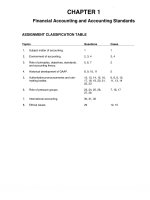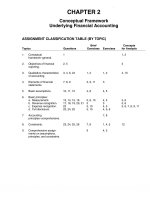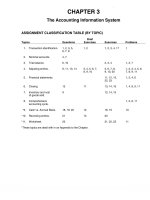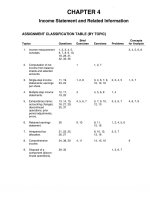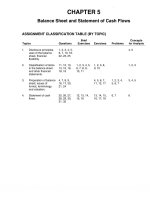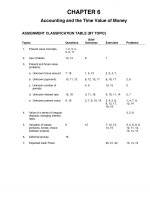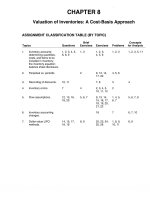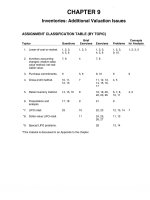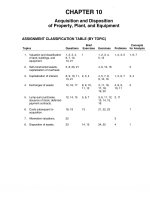Solution manual intermediate accounting 14e kieso weygandt warfield ch06
Bạn đang xem bản rút gọn của tài liệu. Xem và tải ngay bản đầy đủ của tài liệu tại đây (580.19 KB, 86 trang )
CHAPTER 6
Accounting and the Time Value of Money
ASSIGNMENT CLASSIFICATION TABLE (BY TOPIC)
Brief
Exercises
Exercises
13, 14
8
1
a. Unknown future amount.
7, 19
1, 5, 13
2, 3, 4, 7
b. Unknown payments.
10, 11, 12
6, 12,
15, 17
8, 16, 17
2, 6
4, 9
10, 15
2
Topics
Questions
1.
Present value concepts.
1, 2, 3, 4,
5, 9, 17
2.
Use of tables.
3.
Present and future value
problems:
c. Unknown number of
periods.
Problems
d. Unknown interest rate.
15, 18
3, 11, 16
9, 10, 11, 14
2, 7
e. Unknown present value.
8, 19
2, 7, 8,
10, 14
3, 4, 5, 6,
8, 12, 17,
18, 19
1, 4, 7, 9,
13, 14
4.
Value of a series of irregular
deposits; changing interest
rates.
3, 5, 8
5.
Valuation of leases,
pensions, bonds; choice
between projects.
6
6.
Deferred annuity.
16
7.
Expected Cash Flows.
15
7, 12, 13,
14, 15
3, 5, 6, 8, 9,
10, 11, 12,
13, 14, 15
20, 21, 22
13, 14, 15
Copyright © 2011 John Wiley & Sons, Inc. Kieso, Intermediate Accounting, 14/e, Solutions Manual (For Instructor Use Only)
61
ASSIGNMENT CLASSIFICATION TABLE (BY LEARNING OBJECTIVE)
Learning Objectives
Brief
Exercises
Exercises
Problems
1.
Identify accounting topics where the time
value of money is relevant.
2.
Distinguish between simple and compound
interest.
2
3.
Use appropriate compound interest tables.
1
4.
Identify variables fundamental to solving
interest problems.
5.
Solve future and present value of 1 problems.
1, 2, 3,
4, 7, 8
2, 3, 6, 9,
10, 15
1, 2, 3, 5,
7, 9, 10
6.
Solve future value of ordinary and annuity
due problems.
5, 6, 9, 13
3, 4, 6,
15, 16
2, 7
7.
Solve present value of ordinary and annuity
due problems.
10, 11, 12,
14, 16, 17
3, 4, 5, 6,
11, 12, 17,
18, 19
1, 2, 3, 4, 5,
7, 8, 9, 10,
13, 14
8.
Solve present value problems related
to deferred annuities and bonds.
15
7, 8, 13, 14
6, 11, 12, 15
9.
Apply expected cash flows to present
value measurement.
20, 21, 22
13, 14, 15
62
Copyright © 2011 John Wiley & Sons, Inc. Kieso, Intermediate Accounting, 14/e, Solutions Manual (For Instructor Use Only)
ASSIGNMENT CHARACTERISTICS TABLE
Item
Description
Level of
Difficulty
Time
(minutes)
E61
E62
E63
E64
E65
E66
E67
E68
E69
E610
E611
E612
E613
E614
E615
E616
E617
E618
E619
E620
E621
E622
Using interest tables.
Simple and compound interest computations.
Computation of future values and present values.
Computation of future values and present values.
Computation of present value.
Future value and present value problems.
Computation of bond prices.
Computations for a retirement fund.
Unknown rate.
Unknown periods and unknown interest rate.
Evaluation of purchase options.
Analysis of alternatives.
Computation of bond liability.
Computation of pension liability.
Investment decision.
Retirement of debt.
Computation of amount of rentals.
Least costly payoff.
Least costly payoff.
Expected cash flows.
Expected cash flows and present value.
Fair value estimate.
Simple
Simple
Simple
Moderate
Simple
Moderate
Moderate
Simple
Moderate
Simple
Moderate
Simple
Moderate
Moderate
Moderate
Simple
Simple
Simple
Simple
Simple
Moderate
Moderate
5–10
5–10
10–15
15–20
10–15
15–20
12–17
10–15
5–10
10–15
10–15
10–15
15–20
15–20
15–20
10–15
10–15
10–15
10–15
5–10
15–20
15–20
P61
P62
P63
P64
P65
P66
P67
P68
P69
P610
P611
P612
P613
P614
P615
Various time value situations.
Various time value situations.
Analysis of alternatives.
Evaluating payment alternatives.
Analysis of alternatives.
Purchase price of a business.
Time value concepts applied to solve business problems.
Analysis of alternatives.
Analysis of business problems.
Analysis of lease vs. purchase.
Pension funding.
Pension funding.
Expected cash flows and present value.
Expected cash flows and present value.
Fair value estimate.
Moderate
Moderate
Moderate
Moderate
Moderate
Moderate
Complex
Moderate
Complex
Complex
Complex
Moderate
Moderate
Moderate
Complex
15–20
15–20
20–30
20–30
20–25
25–30
30–35
20–30
30–35
30–35
25–30
20–25
20–25
20–25
20–25
Copyright © 2011 John Wiley & Sons, Inc. Kieso, Intermediate Accounting, 14/e, Solutions Manual (For Instructor Use Only)
63
SOLUTIONS TO CODIFICATION EXERCISES
CE61
(a) According to the Master Glossary, present value is a tool used to link uncertain future amounts
(cash flows or values) to a present amount using a discount rate (an application of the income
approach) that is consistent with value maximizing behavior and capital market equilibrium.
Present value techniques differ in how they adjust for risk and in the type of cash flows they use.
(b) The discount rate adjustment technique is a present value technique that uses a riskadjusted
discount rate and contractual, promised, or most likely cash flows.
(c) Other codification references to present value are at (1) FASB ASC 820103533 and (2) FASB
ASC 8201055554. Details for these references follow.
1.
820 Fair Value Measurements and Disclosures > 10 Overall > 35 Subsequent Measurement
3533 Those valuation techniques include the following:
a. Present value techniques
b. Optionpricing models (which incorporate present value techniques), such as the
BlackScholesMerton formula (a closedform model) and a binomial model (a
lattice model)
c. The multiperiod excess earnings method, which is used to measure the fair value of
certain intangible assets.
2.
820 Fair Value Measurements and Disclosures > 10 Overall > 55 Implementation General,
paragraph 554 >>> Present Value Techniques
554 FASB Concepts Statement No. 7, Using Cash Flow Information and Present Value in
Accounting Measurements, provides guidance for using present value techniques to
measure fair value. That guidance focuses on a traditional or discount rate adjustment
technique and an expected cash flow (expected present value) technique. This Section
clarifies that guidance. (That guidance is included or otherwise referred to principally in
paragraphs 39–46, 51, 62–71, 114, and 115 of Concepts Statement 7.) This Section
neither prescribes the use of one specific present value technique nor limits the use of
present value techniques to measure fair value to the techniques discussed herein. The
present value technique used to measure fair value will depend on facts and cir
cumstances specific to the asset or liability being measured (for example, whether
comparable assets or liabilities can be observed in the market) and the availability of
sufficient data.
CE62
Answers will vary. By entering the phrase “present value” in the search window, a list of references to
the term is provided. The site allows you to narrow the search to assets, liabilities, revenues, and
expenses.
64
Copyright © 2011 John Wiley & Sons, Inc. Kieso, Intermediate Accounting, 14/e, Solutions Manual (For Instructor Use Only)
(a) Asset reference: 350 Intangibles—Goodwill and Other > 20 Goodwill > 50 Disclosure > Goodwill
Impairment Loss > Information for Each Period for Which a Statement of Financial Position Is
Presented
Copyright © 2011 John Wiley & Sons, Inc. Kieso, Intermediate Accounting, 14/e, Solutions Manual (For Instructor Use Only)
65
CE62 (Continued)
501 The changes in the carrying amount of goodwill during the period shall be disclosed, including
the following (see Example 3 [paragraph 350205524]):
a. The aggregate amount of goodwill acquired.
b. The aggregate amount of impairment losses recognized.
c. The amount of goodwill included in the gain or loss on disposal of all or a portion of a
reporting unit.
Entities that report segment information in accordance with Topic 280 shall provide the
above information about goodwill in total and for each reportable segment and shall disclose
any significant changes in the allocation of goodwill by reportable segment. If any portion of
goodwill has not yet been allocated to a reporting unit at the date the financial statements
are issued, that unallocated amount and the reasons for not allocating that amount shall be
disclosed.
> Goodwill Impairment Loss
502 For each goodwill impairment loss recognized, all of the following information shall be dis
closed in the notes to the financial statements that include the period in which the impair
ment loss is recognized:
a. A description of the facts and circumstances leading to the impairment.
b. The amount of the impairment loss and the method of determining the fair value of the
associated reporting unit (whether based on quoted market prices, prices of comparable
businesses, a present value or other valuation technique, or a combination thereof).
c. If a recognized impairment loss is an estimate that has not yet been finalized (see
paragraphs 350203518 through 19), that fact and the reasons therefore and, in sub
sequent periods, the nature and amount of any significant adjustments made to the initial
estimate of the impairment loss.
(b) Liability reference: 410 Asset Retirement and Environmental Obligations > 20 Asset Retirement
Obligations > 30 Initial Measurement
Determination of a Reasonable Estimate of Fair Value
301 An expected present value technique will usually be the only appropriate technique with which
to estimate the fair value of a liability for an asset retirement obligation. An entity, when
using that technique, shall discount the expected cash flows using a creditadjusted riskfree
rate. Thus, the effect of an entity’s credit standing is reflected in the discount rate rather
than in the expected cash flows. Proper application of a discount rate adjustment technique
entails analysis of at least two liabilities—the liability that exists in the marketplace and has
an observable interest rate and the liability being measured. The appropriate rate of interest
for the cash flows being measured must be inferred from the observable rate of interest of
some other liability, and to draw that inference the characteristics of the cash flows must be
similar to those of the liability being measured. Rarely, if ever, would there be an observable
rate of interest for a liability that has cash flows similar to an asset retirement obligation being
measured. In addition, an asset retirement obligation usually will have uncertainties in both
timing and amount. In that circumstance, employing a discount rate adjustment technique,
where uncertainty is incorporated into the rate, will be difficult, if not impossible. See
paragraphs 410205513 through 5517 and Example 2 (paragraph 410205535).
66
Copyright © 2011 John Wiley & Sons, Inc. Kieso, Intermediate Accounting, 14/e, Solutions Manual (For Instructor Use Only)
CE62 (Continued)
(c) Revenue or Expense reference: 720 Other Expenses> 25 Contributions Made> 30 Initial Measurement
301 Contributions made shall be measured at the fair values of the assets given or, if made in
the form of a settlement or cancellation of a donee’s liabilities, at the fair value of the liabili
ties cancelled.
302 Unconditional promises to give that are expected to be paid in less than one year may
be measured at net settlement value because that amount, although not equivalent to the
present value of estimated future cash flows, results in a reasonable estimate of fair value.
CE63
Interest cost includes interest recognized on obligations having explicit interest rates, interest imputed
on certain types of payables in accordance with Subtopic 83530, and interest related to a capital lease
determined in accordance with Subtopic 84030. With respect to obligations having explicit interest
rates, interest cost includes amounts resulting from periodic amortization of discount or premium and
issue costs on debt.
According to the discussion at: 835 Interest> 30 Imputation of Interest
051
This Subtopic addresses the imputation of interest.
052
Business transactions often involve the exchange of cash or property, goods, or services for a
note or similar instrument. When a note is exchanged for property, goods, or services in a
bargained transaction entered into at arm’s length, there should be a general presumption that
the rate of interest stipulated by the parties to the transaction represents fair and adequate
compensation to the supplier for the use of the related funds. That presumption, however, must
not permit the form of the transaction to prevail over its economic substance and thus would not
apply if interest is not stated, the stated interest rate is unreasonable, or the stated face amount
of the note is materially different from the current cash sales price for the same or similar items
or from the market value of the note at the date of the transaction. The use of an interest rate
that varies from prevailing interest rates warrants evaluation of whether the face amount and
the stated interest rate of a note or obligation provide reliable evidence for properly recording the
exchange and subsequent related interest.
053 This Subtopic provides guidance for the appropriate accounting when the face amount of a note
does not reasonably represent the present value of the consideration given or received in the
exchange. This circumstance may arise if the note is noninterestbearing or has a stated
interest rate that is different from the rate of interest appropriate for the debt at the date of the
transaction. Unless the note is recorded at its present value in this circumstance, the sales price
and profit to a seller in the year of the transaction and the purchase price and cost to the buyer
are misstated, and interest income and interest expense in subsequent periods are also
misstated.
Copyright © 2011 John Wiley & Sons, Inc. Kieso, Intermediate Accounting, 14/e, Solutions Manual (For Instructor Use Only)
67
ANSWERS TO QUESTIONS
1. Money has value because with it one can acquire assets and services and discharge obligations.
The holding, borrowing or lending of money can result in costs or earnings. And the longer the
time period involved, the greater the costs or the earnings. The cost or earning of money as a
function of time is the time value of money.
Accountants must have a working knowledge of compound interest, annuities, and present value
concepts because of their application to numerous types of business events and transactions
which require proper valuation and presentation. These concepts are applied in the following
areas: (1) sinking funds, (2) installment contracts, (3) pensions, (4) longterm assets, (5) leases,
(6) notes receivable and payable, (7) business combinations, (8) amortization of premiums and
discounts, and (9) estimation of fair value.
2. Some situations in which present value measures are used in accounting include:
(a) Notes receivable and payable—these involve single sums (the face amounts) and may
involve annuities, if there are periodic interest payments.
(b) Leases—involve measurement of assets and obligations, which are based on the present value
of annuities (lease payments) and single sums (if there are residual values to be paid at the
conclusion of the lease).
(c) Pensions and other deferred compensation arrangements—involve discounted future
annuity payments that are estimated to be paid to employees upon retirement.
(d) Bond pricing—the price of bonds payable is comprised of the present value of the principal
or face value of the bond plus the present value of the annuity of interest payments.
(e) Longterm assets—evaluating various longterm investments or assessing whether an asset
is impaired requires determining the present value of the estimated cash flows (may be single
sums and/or an annuity).
3. Interest is the payment for the use of money. It may represent a cost or earnings depending upon
whether the money is being borrowed or loaned. The earning or incurring of interest is a function
of the time, the amount of money, and the risk involved (reflected in the interest rate).
Simple interest is computed on the amount of the principal only, while compound interest is com
puted on the amount of the principal plus any accumulated interest. Compound interest involves
interest on interest while simple interest does not.
4. The interest rate generally has three components:
(a) Pure rate of interest—This would be the amount a lender would charge if there were no
possibilities of default and no expectation of inflation.
(b) Expected inflation rate of interest—Lenders recognize that in an inflationary economy, they
are being paid back with less valuable dollars. As a result, they increase their interest rate to
compensate for this loss in purchasing power. When inflationary expectations are high,
interest rates are high.
(c) Credit risk rate of interest—The government has little or no credit risk (i.e., risk of
nonpayment) when it issues bonds. A business enterprise, however, depending upon its
financial stability, profitability, etc. can have a low or a high credit risk.
Accountants must have knowledge about these components because these components are
essential in identifying an appropriate interest rate for a given company or investor at any given
moment.
5. (a)
(b)
(c)
(d)
Present value of an ordinary annuity at 8% for 10 periods (Table 64).
Future value of 1 at 8% for 10 periods (Table 61).
Present value of 1 at 8% for 10 periods (Table 62).
Future value of an ordinary annuity at 8% for 10 periods (Table 63).
68
Copyright © 2011 John Wiley & Sons, Inc. Kieso, Intermediate Accounting, 14/e, Solutions Manual (For Instructor Use Only)
Questions Chapter 6 (Continued)
6. He should choose quarterly compounding, because the balance in the account on which interest
will be earned will be increased more frequently, thereby resulting in more interest earned on the
investment. This is shown in the following calculation:
Semiannual compounding, assuming the amount is invested for 2 years:
n = 4
$1,500 X 1.16986 = $1,754.79
i = 4
Quarterly compounding, assuming the amount is invested for 2 years:
n = 8
$1,500 X 1.17166 = $1,757.49
i = 2
Thus, with quarterly compounding, Jose could earn $2.70 more.
7. $26,897.80 = $20,000 X 1.34489 (future value of 1 at 21/2 for 12 periods).
8. $44,671.20 = $80,000 X .55839 (present value of 1 at 6% for 10 periods).
9. An annuity involves (1) periodic payments or receipts, called rents, (2) of the same amount,
(3) spread over equal intervals, (4) with interest compounded once each interval.
Rents occur at the end of the intervals for ordinary annuities while the rents occur at the beginning
of each of the intervals for annuities due.
10. Amount paid each year = $40,000 (present value of an ordinary annuity at 12% for 4 years).
3.03735
Amount paid each year = $13,169.37.
11. Amount deposited each year = $200,000 (future value of an ordinary annuity at 10% for
4.64100 4 years).
Amount deposited each year = $43,094.16.
12. Amount deposited each year = $200,000 [future value of an annuity due at 10% for 4 years
5.10510 (4.64100 X 1.10)].
Amount deposited each year = $39,176.51.
13. The process for computing the future value of an annuity due using the future value of an ordinary
annuity interest table is to multiply the corresponding future value of the ordinary annuity by one
plus the interest rate. For example, the factor for the future value of an annuity due for 4 years at
12% is equal to the factor for the future value of an ordinary annuity times 1.12.
14. The basis for converting the present value of an ordinary annuity table to the present value of an
annuity due table involves multiplying the present value of an ordinary annuity factor by one plus
the interest rate.
Copyright © 2011 John Wiley & Sons, Inc. Kieso, Intermediate Accounting, 14/e, Solutions Manual (For Instructor Use Only)
69
Questions Chapter 6 (Continued)
15. Present value = present value of an ordinary annuity of $25,000 for 20 periods at? percent.
$245,000 = present value of an ordinary annuity of $25,000 for 20 periods at? percent.
Present value of an ordinary annuity for 20 periods at? percent =
$245,000 = 9.8.
$25,000
The factor 9.8 is closest to 9.81815 in the 8% column (Table 64).
16. 4.96764 Present value of ordinary annuity at 12% for eight periods.
2.40183 Present value of ordinary annuity at 12% for three periods.
2.56581 Present value of ordinary annuity at 12% for eight periods, deferred three periods.
The present value of the five rents is computed as follows:
2.56581 X $20,000 = $51,316.20.
17. (a)
(b)
(c)
(d)
Present value of an annuity due.
Present value of 1.
Future value of an annuity due.
Future value of 1.
18. $27,600 = PV of an ordinary annuity of $6,900 for five periods at? percent.
$27,600 = PV of an ordinary annuity for five periods at? percent.
$6,900
4.0 = PV of an ordinary annuity for five periods at?
4.0 = approximately 8%.
19. The IRS argues that the future reserves should be discounted to present value. The result would
be smaller reserves and therefore less of a charge to income. As a result, income would be higher
and income taxes may therefore be higher as well.
610
Copyright © 2011 John Wiley & Sons, Inc. Kieso, Intermediate Accounting, 14/e, Solutions Manual (For Instructor Use Only)
SOLUTIONS TO BRIEF EXERCISES
BRIEF EXERCISE 61
8% annual interest
i = 8%
PV = $15,000 FV = ?
0
1
2 3
n = 3
FV = $15,000 (FVF3, 8%)
FV = $15,000 (1.25971)
FV = $18,896
8% annual interest, compounded semiannually
i = 4%
PV = $15,000 FV = ?
0
1
2
3
4
5 6
n = 6
FV = $15,000 (FVF6, 4%)
FV = $15,000 (1.26532)
FV = $18,980
Copyright © 2011 John Wiley & Sons, Inc. Kieso, Intermediate Accounting, 14/e, Solutions Manual (For Instructor Use Only)
611
BRIEF EXERCISE 62
12% annual interest
i = 12%
PV = ? FV = $25,000
0
1
2
n = 4
3 4
PV = $25,000 (PVF4, 12%)
PV = $25,000 (.63552)
PV = $15,888
12% annual interest, compounded quarterly
i = 3%
PV = ? FV = $25,000
0
1
2
14
15 16
n = 16
PV = $25,000 (PVF16, 3%)
PV = $25,000 (.62317)
PV = $15,579
612
Copyright © 2011 John Wiley & Sons, Inc. Kieso, Intermediate Accounting, 14/e, Solutions Manual (For Instructor Use Only)
BRIEF EXERCISE 63
i = ?
PV = $30,000 FV = $150,000
0
1
2
FV = PV (FVF21, i)
n = 21
$150,000 = $30,000 (FVF21, i)
19
OR
20 21
PV = FV (PVF21, i)
$30,000 = $150,000 (PVF21, i)
FVF21, i = 5.0000
PVF21, i = .20000
i = 8%
i = 8%
BRIEF EXERCISE 64
i = 5%
PV = $10,000 FV = $17,100
0
FV = PV (FVFn, 5%)
$17,100 = $10,000 (FVFn, 5%)
?
n = ?
OR
PV = FV (PVFn, 5%)
$10,000 = $17,100 (PVFn, 5%)
FVFn, 5% = 1.71000
PVFn, 5% = .58480
n = 11 years
n = 11 years
Copyright © 2011 John Wiley & Sons, Inc. Kieso, Intermediate Accounting, 14/e, Solutions Manual (For Instructor Use Only)
613
BRIEF EXERCISE 65
First payment today (Annuity Due)
i = 12%
R = FV – AD =
$8,000 $8,000 $8,000 $8,000 $8,000 ?
0
1
2
n = 20
18
19 20
FV – AD = $8,000 (FVF – OA20, 12%) 1.12
FV – AD = $8,000 (72.05244) 1.12
FV – AD = $645,590
First payment at yearend (Ordinary Annuity)
i = 12%
FV – OA =
?
$8,000 $8,000 $8,000 $8,000 $8,000
0
1
2
n = 20
18
19 20
FV – OA = $8,000 (FVF – OA20, 12%)
FV – OA = $8,000 (72.05244)
FV – OA = $576,420
614
Copyright © 2011 John Wiley & Sons, Inc. Kieso, Intermediate Accounting, 14/e, Solutions Manual (For Instructor Use Only)
BRIEF EXERCISE 66
i = 11%
FV – OA =
R = ? ? ? ? $250,000
0
1
2
8
n = 10
9 10
$250,000 = R (FVF – OA10, 11%)
$250,000 = R (16.72201)
$250,000
16.72201
= R
R = $14,950
BRIEF EXERCISE 67
12% annual interest
i = 12%
PV = ? FV = $300,000
0
1
2
3
n = 5
4 5
PV = $300,000 (PVF5, 12%)
PV = $300,000 (.56743)
PV = $170,229
Copyright © 2011 John Wiley & Sons, Inc. Kieso, Intermediate Accounting, 14/e, Solutions Manual (For Instructor Use Only)
615
BRIEF EXERCISE 68
With quarterly compounding, there will be 20 quarterly compounding periods,
at 1/4 the interest rate:
PV = $300,000 (PVF20, 3%)
PV = $300,000 (.55368)
PV = $166,104
BRIEF EXERCISE 69
i = 10%
FV – OA =
R = $100,000
$16,380 $16,380 $16,380
0
1
2
n = ?
n
$100,000 = $16,380 (FVF – OAn, 10%)
$100,000
FVF – OAn, 10% =
= 6.10501
16,380
Therefore, n = 5 years
616
Copyright © 2011 John Wiley & Sons, Inc. Kieso, Intermediate Accounting, 14/e, Solutions Manual (For Instructor Use Only)
BRIEF EXERCISE 610
First withdrawal at yearend
i = 8%
PV – OA = R =
? $30,000 $30,000 $30,000 $30,000 $30,000
0
1
2
n = 10
8
9 10
PV – OA = $30,000 (PVF – OA10, 8%)
PV – OA = $30,000 (6.71008)
PV – OA = $201,302
First withdrawal immediately
i = 8%
PV – AD =
?
R =
$30,000 $30,000 $30,000 $30,000 $30,000
0
1
2
n = 10
8
9 10
PV – AD = $30,000 (PVF – AD10, 8%)
PV – AD = $30,000 (7.24689)
PV – AD = $217,407
Copyright © 2011 John Wiley & Sons, Inc. Kieso, Intermediate Accounting, 14/e, Solutions Manual (For Instructor Use Only)
617
BRIEF EXERCISE 611
i = ?
PV = R =
$793.15 $75 $75 $75 $75 $75
0
1
2
n = 12
10
11 12
$793.15 = $75 (PVF – OA12, i)
$793.15
PVF12, i =
= 10.57533
$75
Therefore, i = 2% per month or 24% per year.
BRIEF EXERCISE 612
i = 8%
PV =
$300,000 R = ? ? ? ? ?
0
1
2
n = 20
18
19 20
$300,000 = R (PVF – OA20, 8%)
$300,000 = R (9.81815)
R = $30,556
618
Copyright © 2011 John Wiley & Sons, Inc. Kieso, Intermediate Accounting, 14/e, Solutions Manual (For Instructor Use Only)
BRIEF EXERCISE 613
i = 12%
R =
$30,000 $30,000 $30,000 $30,000 $30,000
12/31/11 12/31/12 12/31/13
12/31/17 12/31/18 12/31/19
n = 8
FV – OA = $30,000 (FVF – OA8, 12%)
FV – OA = $30,000 (12.29969)
FV – OA = $368,991
BRIEF EXERCISE 614
i = 8%
PV – OA =
R =
?
0
$25,000 $25,000
1
2
3
4
5
n = 4
PV – OA = $25,000 (PVF – OA12–4, 8%)
$25,000 $25,000
6
11 12
n = 8
PV – OA = $25,000 (PVF – OA8, 8%)(PVF4, 8%)
OR
PV – OA = $25,000 (7.53608 – 3.31213) PV – OA = $25,000 (5.74664)(.73503)
PV – OA = $105,599
PV – OA = $105,599
Copyright © 2011 John Wiley & Sons, Inc. Kieso, Intermediate Accounting, 14/e, Solutions Manual (For Instructor Use Only)
619
BRIEF EXERCISE 615
i = 8%
PV = ?
PV – OA = R =
? $140,000 $140,000
0
1
$2,000,000
$140,000 $140,000 $140,000
2
8
9 10
n = 10
$2,000,000 (PVF10, 8%) = $2,000,000 (.46319) = $ 926,380
$140,000 (PVF – OA10, 8%) = $140,000 (6.71008) = 939,411
$1,865,791
BRIEF EXERCISE 616
PV – OA = $20,000
$4,727.53 $4,727.53
0
1
$20,000
(PV – OA6, i%)
(PV – OA6, i%)
Therefore, i%
2
$4,727.53 $4,727.53
5 6
= $4,727.53 (PV – OA6, i%)
= $20,000 ÷ $4,727.53
= 4.23054
= 11
620
Copyright © 2011 John Wiley & Sons, Inc. Kieso, Intermediate Accounting, 14/e, Solutions Manual (For Instructor Use Only)
BRIEF EXERCISE 617
PV – AD = $20,000
$? $?
0
1
$?
$?
2
5 6
$20,000 = Payment (PV – AD6, 11%)
$20,000 ÷ (PV – AD6, 11%) = Payment
$20,000 ÷ 4.6959 = $4,259
Copyright © 2011 John Wiley & Sons, Inc. Kieso, Intermediate Accounting, 14/e, Solutions Manual (For Instructor Use Only)
621
SOLUTIONS TO EXERCISES
EXERCISE 61 (5–10 minutes)
1.
a.
b.
c.
(a)
Rate of Interest
9%
2%
5%
2.
a.
b.
c.
9%
4%
3%
(b)
Number of Periods
9
20
30
25
30
28
EXERCISE 62 (5–10 minutes)
(a)
Simple interest of $2,400 ($30,000 X 8%) per year X 8....
Principal..............................................................................
Total withdrawn.........................................................
(b)
Interest compounded annually—Future value of
1 @ 8% for 8 periods....................................................
Total withdrawn.........................................................
(c)
Interest compounded semiannually—Future
value of 1 @ 4% for 16 periods....................................
Total withdrawn.........................................................
$19,200
30,000
$49,200
1.85093
X $30,000
$55,528
1.87298
X $30,000
$56,189
EXERCISE 63 (10–15 minutes)
(a)
$9,000 X 1.46933 = $13,224.
(b)
$9,000 X .43393 = $3,905.
(c)
$9,000 X 31.77248 = $285,952.
(d)
$9,000 X 12.46221 = $112,160.
622
Copyright © 2011 John Wiley & Sons, Inc. Kieso, Intermediate Accounting, 14/e, Solutions Manual (For Instructor Use Only)
EXERCISE 64 (15–20 minutes)
(a)
Future value of an ordinary
annuity of $5,000 a period
for 20 periods at 8%
$228,809.80 ($5,000 X 45.76196)
Factor (1 + .08)
X 1.08
Future value of an annuity
due of $5,000 a period at 8% $ 247,115
(b)
Present value of an ordinary
annuity of $2,500 for 30
periods at 10%
Factor (1 + .10)
Present value of annuity
due of $2,500 for 30 periods
at 10%
(c)
(d)
Future value of an ordinary
annuity of $2,000 a period
for 15 periods at 10%
Factor (1 + 10)
Future value of an annuity
due of $2,000 a period
for 15 periods at 10%
Present value of an ordinary
annuity of $3,000 for 6
periods at 9%
Factor (1 + .09)
Present value of an annuity
due of $3,000 for 6 periods
at 9%
$ 23,567.28 ($2,500 X 9.42691)
X 1.10
$ 25,924 (Or see Table 65 which
gives $25,924.03)
$ 63,544.96 ($2,000 X 31.77248)
X 1.10
$ 69,900
$ 13,457.76 ($3,000 X 4.48592)
X 1.09
$ 14,669 (Or see Table 65)
EXERCISE 65 (10–15 minutes)
(a)
$50,000 X 4.96764 = $248,382.
(b)
$50,000 X 8.31256 = $415,628.
(c)
($50,000 X 3.03735 X .50663) = $76,941.
or (5.65022 – 4.11141) X $50,000 = $76,941 (difference of $.13 due to
rounding).
Copyright © 2011 John Wiley & Sons, Inc. Kieso, Intermediate Accounting, 14/e, Solutions Manual (For Instructor Use Only)
623
EXERCISE 66 (15–20 minutes)
(a)
(b)
(c)
Future value of $12,000 @ 10% for 10 years
($12,000 X 2.59374) =
Future value of an ordinary annuity of $620,000
at 10% for 15 years ($620,000 X 31.77248)
Deficiency ($20,000,000 – $19,698,937)
$ 31,125
$19,698,937
$ 301,063
$75,000 discounted at 8% for 10 years:
$75,000 X .46319 =
$ 34,739
Accept the bonus of $40,000 now.
(Also, consider whether the 8% is an appropriate discount rate if the
president can earn compound interest at a higher rate without too
much additional risk.)
EXERCISE 67 (12–17 minutes)
(a)
$100,000 X .31524
+ $10,000 X 8.55948
=
=
$31,524.00
85,594.80
$ 117,119
(b)
$100,000 X .23939
+ $10,000 X 7.60608
=
=
$ 23,939
76,061
$ 100,000
(c)
$100,000 X .18270
+ $10,000 X 6.81086
=
=
$ 18,270
68,109
$ 86,379
624
Copyright © 2011 John Wiley & Sons, Inc. Kieso, Intermediate Accounting, 14/e, Solutions Manual (For Instructor Use Only)
EXERCISE 68 (10–15 minutes)
(a)
Present value of an ordinary annuity of 1
for 4 periods @ 8%
Annual withdrawal
Required fund balance on June 30, 2015
(b)
Fund balance at June 30, 2015
Future value of an ordinary annuity at 8%
for 4 years
3.31213
X $25,000
$82,803
$82,803.25
4.50611
= $18,376
Amount of each of four contributions is $18,376
EXERCISE 69 (5–10 minutes)
The rate of interest is determined by dividing the future value by the present
value and then finding the factor in the FVF table with n = 2 that approxi
mates that number:
$118,810 = $100,000 (FVF2, i%)
$118,810 ÷ $100,000 = (FVF2, i%)
1.1881 = (FVF2, i%)—reading across the n = 2 row reveals that i = 9%.
Note: This problem can also be solved using present value tables.
EXERCISE 610 (10–15 minutes)
(a)
The number of interest periods is calculated by first dividing the future
value of $1,000,000 by $148,644, which is 6.72748—the value $1.00 would
accumulate to at 10% for the unknown number of interest periods. The
factor 6.72748 or its approximate is then located in the Future Value of
1 Table by reading down the 10% column to the 20period line; thus, 20 is
the unknown number of years Mark must wait to become a millionaire.
(b)
The unknown interest rate is calculated by first dividing the future value
of $1,000,000 by the present investment of $239,392, which is 4.17725—
the amount $1.00 would accumulate to in 15 years at an unknown
interest rate. The factor or its approximate is then located in the
Future Value of 1 Table by reading across the 15period line to the 10%
column; thus, 10% is the interest rate Elvira must earn on her
investment to become a millionaire.
Copyright © 2011 John Wiley & Sons, Inc. Kieso, Intermediate Accounting, 14/e, Solutions Manual (For Instructor Use Only)
625
